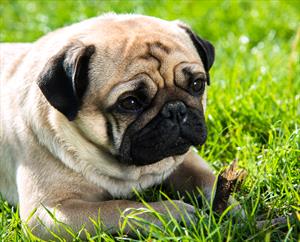Pug owners should relax (some have apparently already asked about getting rid of their dogs)
Pug on lawn

Photo courtesy of Depositphotos
A few quick updates and comments.
Are pugs a high risk breed for SARS-CoV-2?
This question has come up a few times since the report of an infected pug in North Carolina. It has been suggested by some people in news articles that pugs are higher risk for getting infected. Like other brachycephalic (squishy faced) breeds, some pugs are at increased risk of respiratory disease in general. They are also at increased risk of complications if they get a respiratory infection of any kind. But they should otherwise not be at increased risk of getting infected with this particular virus compared to any other similarly exposed dog.
So, pug owners should relax (some have apparently already asked about getting rid of their dogs). If you own a pug, it is probably at increased risk of complications if it gets infected with SARS-CoV-2 (or any other respiratory virus), but it should not be at increased risk of getting infected in the first place, and the odds of any dog getting infected are very low.
Update on two positive cats in New York
Antibodies to SARS-CoV2 were detected in the blood of both cats from New York that tested positive by PCR in late April . This is not unexpected, but it is one more indication that they were truly infected.
Infected Cat in France
In a study of cats owned by people with COVID-19 in France, one cat was identified as positive by PCR. There’s no mention of how many cats were tested (yet). The positive cat had mild respiratory and gastrointestinal disease, and only its rectal swab (not the throat swab) was positive.
This result isn’t surprising either, as it’s likely that a reasonably large number of human-cat infections have occurred. As has been typical so far, the cat had mild disease. I’ve had some anecdotal reports that suggest some cats can get more serious disease but we need to properly investigate those. This report is just one more piece of evidence indicating that human-animal transmission of this virus is occurring. Human and animal health implications of this are probably limited but it’s an area we need to keep studying.
Endangered Animals
While COVID-19 is almost exclusively a human disease, it’s clear there can be spillover into animals. That’s probably of greatest concern in pets, because of the amount of contact we have with them and the susceptibility of some pet species (especially cats and ferrets). However, while we have less contact with other types of animals, there might still be important implications. We don’t know the range of species that can be affected and the potential animal health impacts in each species. We also don’t want this virus establishing itself in wild animals. Ultimately, we want to keep this a “human problem” by preventing movement into animal populations, for the sake of animals and ourselves.
A few different issues with different species are highlighted below.
Bats
Since this virus almost certainly originated in a bat, there’s concern about it moving back to bats. While the bats species we have in North America are quite different from the suspected source bat species (i.e., Chinese horseshoe bat), we’d rather prevent our native bats from being exposed rather than hope that they’re just not effective hosts. Normal research and surveillance activities that put people into bat environments are being curtailed in many areas to reduce the risk that we’ll expose bats. We have no idea what the risk is, but it’s better to be prudent than to have to do damage control.
Tigers
The outbreak of COVID-19 in lions and tigers at the Bronx Zoo raised concerns about risks to wild tiger populations. While there’s less human contact with those animals, they often live in fairly (surprisingly) close proximity to people, and there can (normally) be a lot of people visiting parks and reserves. The risk of infection is probably low, but we want to avoid any health hazards in threatened or endangered populations if we can.
A recent ProMed mail post discussed COVID-19 in a tiger at Pench Tiger Reserve in India. It’s unclear whether the tiger actually had COVID-19. It seems that park staff were concerned because of the reports of COVID-19 at the Bronx Zoo and that their response (i.e. quarantine of staff, banning visitors from the park) was out of abundance of caution rather than an actual diagnosis. Regardless, it’s something that needs to be considered in areas where people can get close to wild cats.
Gorillas
Gorillas are closely related to humans and probably quite susceptible to this virus. The last thing wild gorilla populations need is COVID-19 spreading through them. This is resulting in park closures to protect the animals, with potentially major impacts to local economies (and the parks that protect the animals). Enforcement will be the challenge. Measures are already in place to protect animals from exposure to human respiratory viruses in many parks, and they’re often flouted.